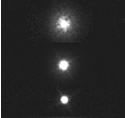
Image credit: NASA
Controllers for the Cassini spacecraft received some good news last week when the latest set of test images came through showing no distortion in its camera system. They became worried last year when haze appeared on the camera after it was heated briefly in a maintenance operation – the haze diffused 70% of the light reaching the camera. Controllers slowly heated and cooled the spacecraft several times, and now the distortion is down to 5%. Cassini will begin orbiting Saturn on July 1, 2004 and it will deliver the piggybacked Huygens probe into the atmosphere of Titan.
Now within two years of reaching Saturn, NASA’s Cassini spacecraft took test images of a star last week that reveal successful results from an extended warming treatment to remove haze that collected on a camera lens last year.
The quality of the new images is virtually the same as star images taken before the haze appeared. In the most recent treatment, the camera had been warmed to 4 degrees Celsius (39 degrees Fahrenheit) for four weeks ending July 9. Four previous treatments at that temperature for varying lengths of time had already removed most of the haze. The camera usually operates at minus 90 C (minus 130 F), one of the temperatures at which test images were taken on July 9 of the star Spica.
“We’re happy with what we’re seeing now,” said Robert Mitchell, Cassini program manager at NASA’s Jet Propulsion Laboratory, Pasadena, Calif. The team will decide in coming weeks whether to proceed with another warming treatment later this year.
Cassini’s narrow-angle camera worked flawlessly for several months before and after a December 2000 flyby of Jupiter. Haze appeared when the camera cooled back to its usual operating temperature after a routine-maintenance heating to 30 C (86F) in mid-2001. Lens hazing from engine exhaust or other sources is always a possibility on interplanetary spacecraft. Planners designed heaters for Cassini’s cameras to cope with just such a situation.
Before treatment, the haze diffused about 70 percent of light coming from a star, by one method of quantifying the problem. Now, the comparable diffusion is about 5 percent, Cassini engineers Charles Avis and Vance Haemmerle report. That’s within one percent of what was seen in images from before the hazing occurred, possibly within the range of statistical noise in the analysis. Comparison images are posted at http://www.jpl.nasa.gov/images/cassinicamera_caption.html.
Additional information about Cassini-Huygens is online at http://saturn.jpl.nasa.gov.
Cassini will begin orbiting Saturn on July 1, 2004, and release its piggybacked Huygens probe about six months later for descent through the thick atmosphere of the moon Titan. Cassini-Huygens is a cooperative mission of NASA, the European Space Agency and the Italian Space Agency. JPL, a division of the California Institute of Technology in Pasadena, manages the mission for NASA’s Office of Space Science, Washington, D.C.
Original Source: NASA/JPL News Release
